Lexus IS250C 2010 Do-It-Yourself Maintenance / LEXUS 2010 IS350C/250C OWNERS MANUAL (OM53A20U)
Manufacturer: LEXUS, Model Year: 2010, Model line: IS250C, Model: Lexus IS250C 2010Pages: 592, PDF Size: 7.18 MB
Page 221 of 592
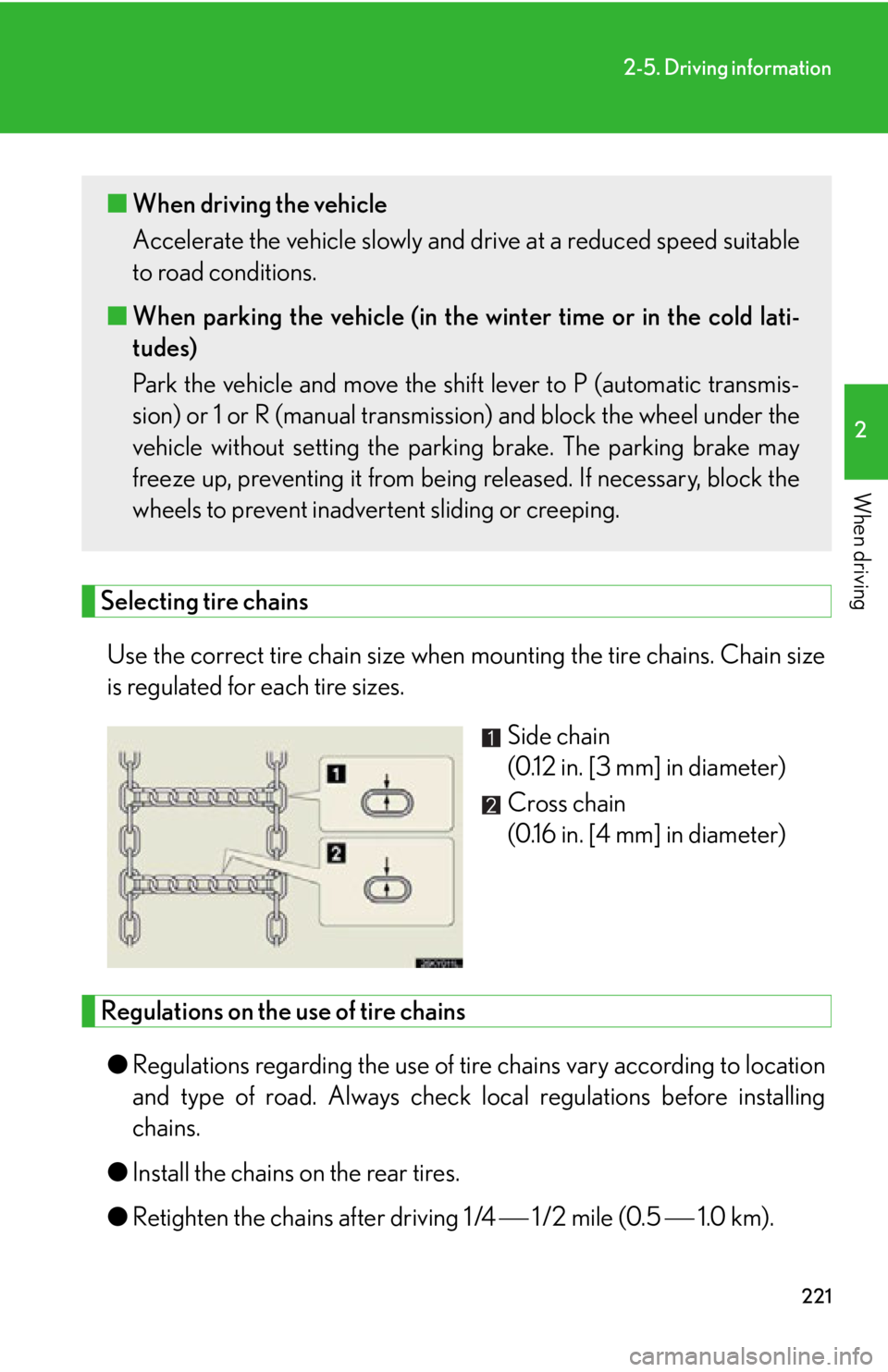
221
2-5. Driving information
2
When driving
Selecting tire chainsUse the correct tire chain size when mounting the tire chains. Chain size
is regulated for each tire sizes.
Side chain
(0.12 in. [3 mm] in diameter)
Cross chain
(0.16 in. [4 mm] in diameter)
Regulations on the use of tire chains
● Regulations regarding the use of tire chains vary according to location
and type of road. Always check local regulations before installing
chains.
● Install the chains on the rear tires.
● Retighten the chains after driving 1 /4 1 /2 mile (0.5 1.0 km).
■When driving the vehicle
Accelerate the vehicle slowly and dr ive at a reduced speed suitable
to road conditions.
■ When parking the vehicle (in the winter time or in the cold lati-
tudes)
Park the vehicle and move the shift lever to P (automatic transmis-
sion) or 1 or R (manual transmission) and block the wheel under the
vehicle without setting the parking brake. The parking brake may
freeze up, preventing it from being released. If necessary, block the
wheels to prevent inadvertent sliding or creeping.
Page 222 of 592
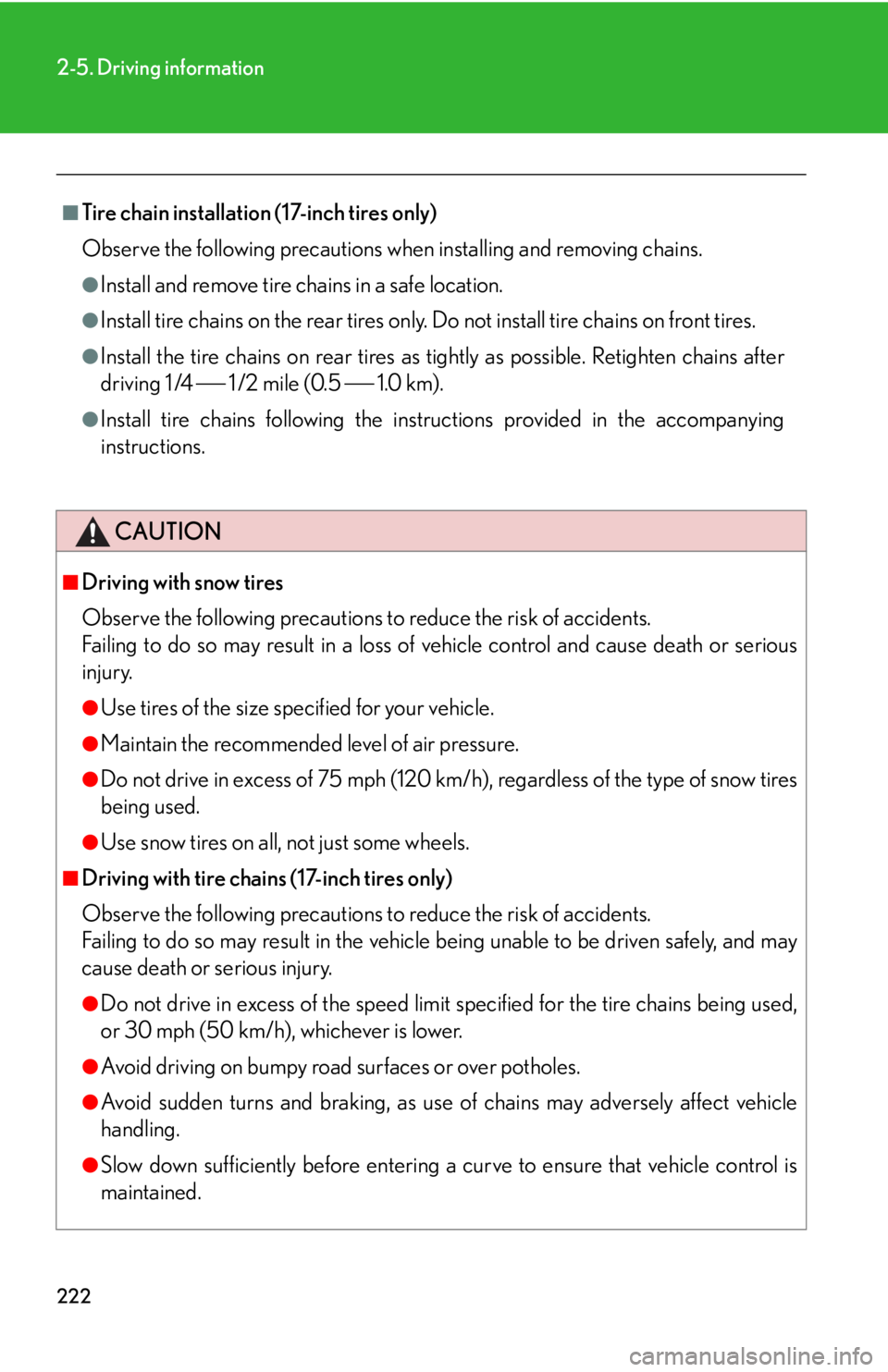
222
2-5. Driving information
■Tire chain installation (17-inch tires only)
Observe the following precautions when installing and removing chains.
●Install and remove tire chains in a safe location.
●Install tire chains on the rear tires only. Do not install tire chains on front tires.
●Install the tire chains on rear tires as tightly as possible. Retighten chains after
driving 1 /4
1/2 mile (0.5 1.0 km).
●Install tire chains following the instructions provided in the accompanying
instructions.
CAUTION
■Driving with snow tires
Observe the following precautions to reduce the risk of accidents.
Failing to do so may result in a loss of vehicle control and cause death or serious
injury.
●Use tires of the size specified for your vehicle.
●Maintain the recommended level of air pressure.
●Do not drive in excess of 75 mph (120 km/h ), regardless of the type of snow tires
being used.
●Use snow tires on all, not just some wheels.
■Driving with tire chains (17-inch tires only)
Observe the following precautions to reduce the risk of accidents.
Failing to do so may result in the vehicle being unable to be driven safely, and may
cause death or serious injury.
●Do not drive in excess of the speed limit specified for the tire chains being used,
or 30 mph (50 km/h), whichever is lower.
●Avoid driving on bumpy road surfaces or over potholes.
●Avoid sudden turns and braking, as use of chains may adversely affect vehicle
handling.
●Slow down sufficiently before entering a curve to ensure that vehicle control is
maintained.
Page 223 of 592

223
2-5. Driving information
2
When driving
NOTICE
■Repairing or replacing snow tires
Request repairs of and obtain replacement snow tires from Lexus dealers or legiti-
mate tire retailers.
This is because the removal and attachment of snow tires affects the operation of
the tire air pressure sensor.
■Fitting tire chains
The tire air pressure sensor may not functi on correctly when tire chains are fitted.
Page 224 of 592

224
2-5. Driving information
Trailer towing
Lexus does not recommend towing a trailer with your vehicle. Lexus also
does not recommend the installation of a tow hitch or the use of a tow hitch
carrier for a wheelchair, scooter, bicycle, etc. Your Lexus is not designed
for trailer towing or for the us e of tow hitch mounted carriers.
Page 225 of 592

225
2-5. Driving information
2
When driving
Dinghy towing (vehicles with an automatic transmission)
NOTICE
■To avoid serious damage to your vehicle
Do not tow your vehicle with four wheels on the ground.
Your vehicle is not designed to be dinghy towed (with 4 wheels on the
ground) behind a motor home.
Page 226 of 592
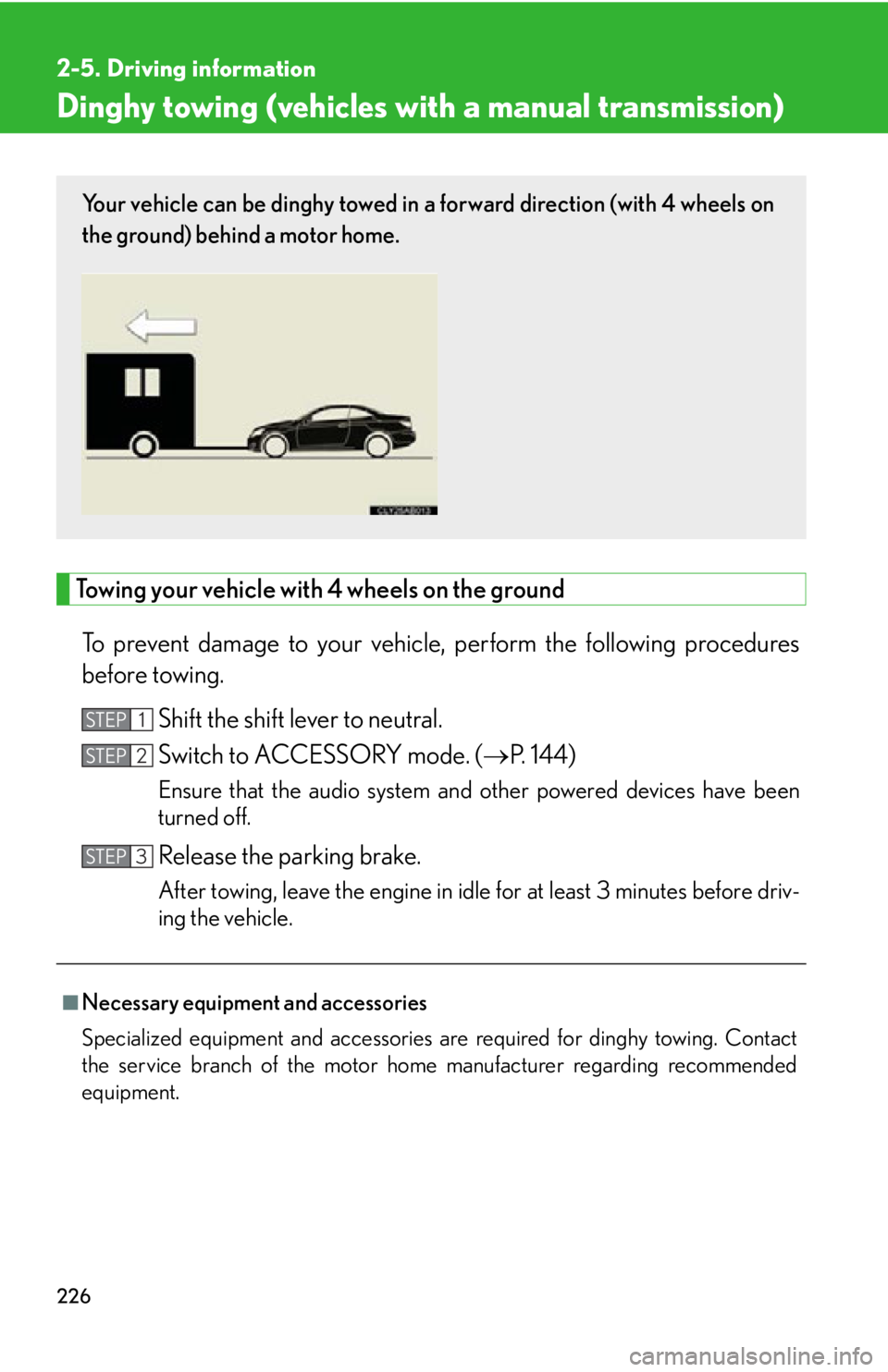
226
2-5. Driving information
Dinghy towing (vehicles with a manual transmission)
Towing your vehicle with 4 wheels on the groundTo prevent damage to your vehicle, perform the following procedures
before towing. Shift the shift lever to neutral.
Switch to ACCESSORY mode. ( P. 144)
Ensure that the audio system and other powered devices have been
turned off.
Release the parking brake.
After towing, leave the engine in idle for at least 3 minutes before driv-
ing the vehicle.
■Necessary equipment and accessories
Specialized equipment and accessories are required for dinghy towing. Contact
the service branch of the motor home manufacturer regarding recommended
equipment.
Your vehicle can be dinghy towed in a forward direction (with 4 wheels on
the ground) behind a motor home.
STEP1
STEP2
STEP3
Page 227 of 592

227
2-5. Driving information
2
When driving
NOTICE
■Dinghy towing direction
■To prevent the steering from locking
Ensure the “ENGINE START STOP” switch is in ACCESSORY mode.
Do not tow the vehicle backwards.
Doing so may cause serious damage.
Page 228 of 592

228
3-1. Using the air conditioning system and defogger
Automatic air conditioning system ........... 230
Rear window and outside rear view mirror
defoggers .............................. 238
3-2. Using the audio system Audio system type ................. 239
Using the radio ....................... 242
Using the CD player ............. 250
Playing back MP3 and WMA discs ........................... 257
Operating an iPod
®.............. 265
Operating a USB memory.................................. 273
Optimal use of the audio system..................................... 282
Using the AUX adapter....... 284
Using the steering wheel audio switches ......... 286
Interior features3
Page 229 of 592
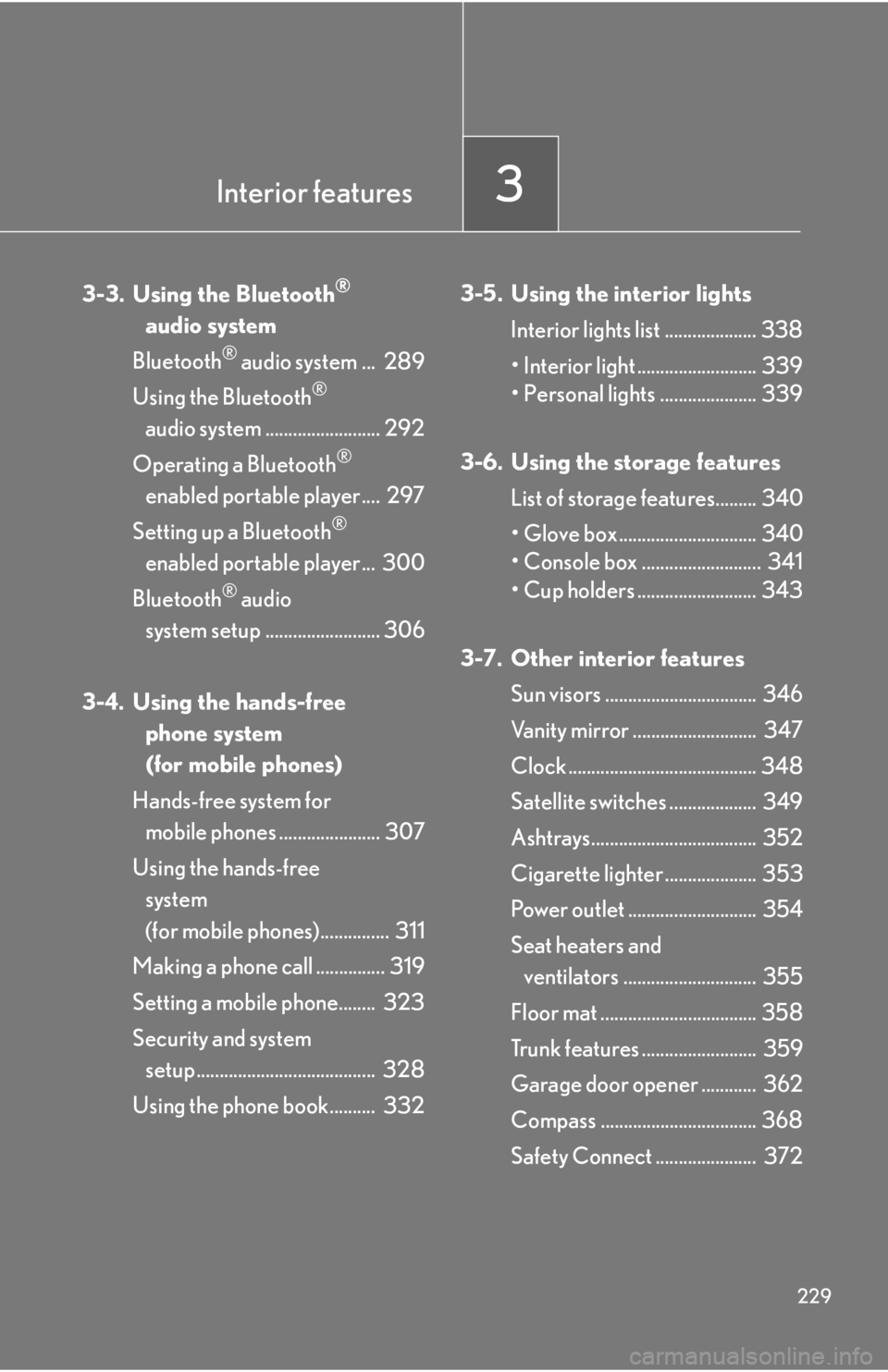
Interior features3
229
3-3. Using the Bluetooth®
audio system
Bluetooth
® audio system ... 289
Using the Bluetooth
®
audio system ......................... 292
Operating a Bluetooth
®
enabled portable player.... 297
Setting up a Bluetooth
®
enabled portable player... 300
Bluetooth
® audio
system setup ......................... 306
3-4. Using the hands-free phone system
(for mobile phones)
Hands-free system for mobile phones ...................... 307
Using the hands-free system
(for mobile phones)............... 311
Making a phone call ............... 319
Setting a mobile phone........ 323
Security and system setup ....................................... 328
Using the phone book.......... 332 3-5. Using the interior lights
Interior lights list .................... 338
• Interior light .......................... 339
• Personal lights ..................... 339
3-6. Using the storage features List of storage features......... 340
• Glove box .............................. 340
• Console box .......................... 341
• Cup holders .......................... 343
3-7. Other interior features Sun visors ................................. 346
Vanity mirror ........................... 347
Clock ......................................... 348
Satellite switches ................... 349
Ashtrays.................................... 352
Cigarette lighter .................... 353
Power outlet ............................ 354
Seat heaters and ventilators ............................. 355
Floor mat .................................. 358
Trunk features ......................... 359
Garage door opener ............ 362
Compass .................................. 368
Safety Connect ...................... 372
Page 230 of 592
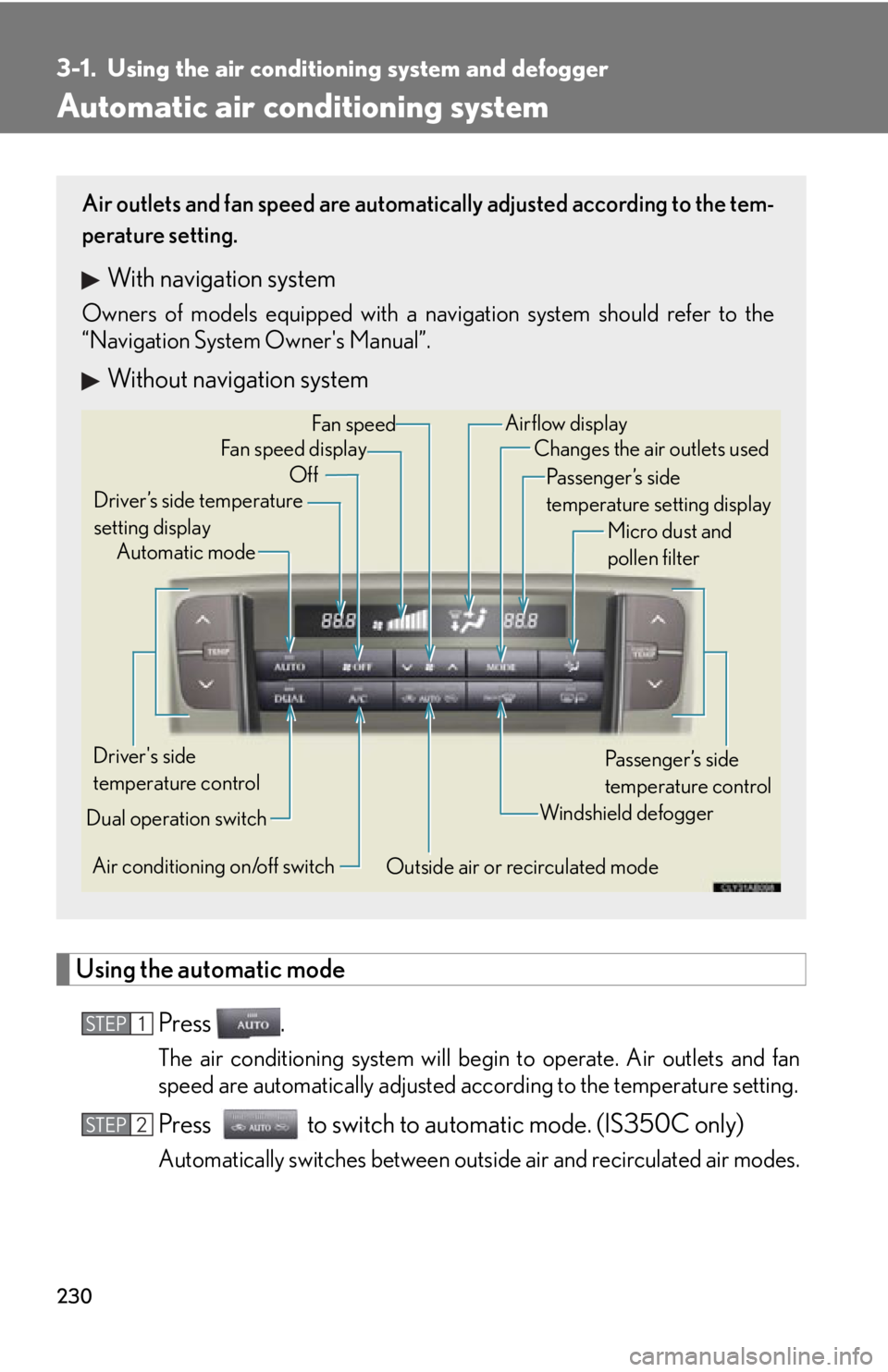
230
3-1. Using the air conditioning system and defogger
Automatic air conditioning system
Using the automatic mode
Press .
The air conditioning system will begin to operate. Air outlets and fan
speed are automatically adjusted according to the temperature setting.
Press to switch to automatic mode. (IS350C only)
Automatically switches between outs ide air and recirculated air modes.
Air outlets and fan speed are automati cally adjusted according to the tem-
perature setting.
With navigation system
Owners of models equipped with a navigation system should refer to the
“Navigation System Owner's Manual”.
Without navigation system
Automatic mode
Driver’s side temperature
setting display Changes the air outlets used
Off Fan speed
Airflow display
Fan speed display
Passenger’s side
temperature setting displayMicro dust and
pollen filter
Driver's side
temperature control
Air conditioning on/off switch Outside air or recirculated modeWindshield defogger
Passenger’s side
temperature control
Dual operation switch
STEP1
STEP2